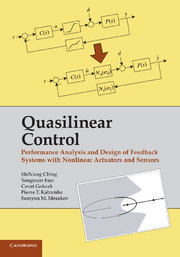 Quasilinear Control
Quasilinear Control Published online by Cambridge University Press: 01 June 2011
This volume has extended major ideas and results of linear control theory to systems with nonlinear actuators and sensors. Namely, the linear frequency domain methods (based on the frequency of harmonic inputs) are extended to the quasilinear frequency domain (based on the bandwidth of random inputs). The linear time domain methods are extended to quasilinear ones by introducing tracking quality indicators (instead of overshoot and settling time) and by modifying the root locus technique (e.g., the saturated root locus). The LQR/LQG methodology has been extended to SLQR/SLQG (where the “S” stands for “saturated”). Although not included in this volume, the H∞ and LMI techniques have also been extended to systems with nonlinearities in sensors and actuators.
In addition, new problems, specific for LPNI systems, have been formulated and solved. These include Instrumented LQR/LQG, where the optimal controller and instrumentation are synthesized simultaneously, and the problem of performance recovery, where the performance losses due nonlinear instrumentation are either contained to a desired level or eliminated altogether.
What made these results possible?
The method of stochastic linearization provided a tool for reducing the nonlinear systems addressed in this volume to quasilinear ones.
The methods of linear control theory could be applied, with some modifications, to the quasilinear systems mentioned above.
The resulting relationships and techniques, as it turns out, are quite similar to those of linear control theory.
To save this book to your Kindle, first ensure [email protected] is added to your Approved Personal Document E-mail List under your Personal Document Settings on the Manage Your Content and Devices page of your Amazon account. Then enter the ‘name’ part of your Kindle email address below. Find out more about saving to your Kindle.
Note you can select to save to either the @free.kindle.com or @kindle.com variations. ‘@free.kindle.com’ emails are free but can only be saved to your device when it is connected to wi-fi. ‘@kindle.com’ emails can be delivered even when you are not connected to wi-fi, but note that service fees apply.
Find out more about the Kindle Personal Document Service.
To save content items to your account, please confirm that you agree to abide by our usage policies. If this is the first time you use this feature, you will be asked to authorise Cambridge Core to connect with your account. Find out more about saving content to Dropbox.
To save content items to your account, please confirm that you agree to abide by our usage policies. If this is the first time you use this feature, you will be asked to authorise Cambridge Core to connect with your account. Find out more about saving content to Google Drive.